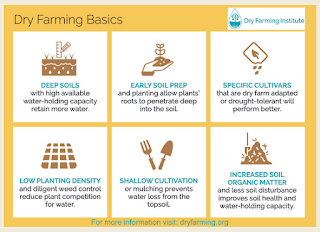From the comments:
Why do you not have rainwater catchment and cisterns?
The return on investment isn't there
It may sound like heresy to use economic terms when talking about growing things and biological systems, but it makes all the sense in the world from my standpoint. The resources I spend on one project are not available to be spent on other projects.
If the contour of the land you are working with is not favorable to the concept (flat or no funneling-features) and if the soil and rainfall regime rarely generate run-off, it feels like pushing a rope.
 |
| This is such a great graphic that I had to shoe-horn it in. Bank the moisture in the soil! Bonus Link (Warning, long...likely to cure insomnia). Many thanks to the benefactor-who-must-remain-unnamed for the links and images. |
If the contour of the land IS favorable but the favorable contour is 1000 feet away from your point-of use or the favorable contour is closer but isn't on your property then you pretty much out-of-luck...you will be transporting water one way or another.
 |
| This screen grab is 200' east-west and is of my Eaton Rapids orchard/gardens. It is on top of a hill and there isn't a lot of slope. |
And, for what it is worth:
- The normal water-table beneath the Upper Orchard is about 25' down.
- The normal water-table beneath the Eaton Rapids orchard is 45' down.
- The normal water-table beneath Southern Belle's orchard is about 6' down but varies significantly by time-of-year.
Right now, the orchards are wide, grassy aisle-ways with the trees planted in strips that have been treated with herbicide. There is white clover and at least four species of grass* growing in the aisle-ways. If I were to install some kind of catchment system, wouldn't I have to cover the grassy aisle-ways with plastic or bentonite?
If I did that, I would lose the benefits of increasing organic matter in the soil, beneficial insects and nitrogen fixation from the clover. The grassy aisle-ways are also pleasant to walk on regardless of the weather. It is hard to say that about bentonite.
Finally, the few local attempts at catchment systems I have personally seen were mosquito breeding nightmares. The cisterns were much too small and the provisions for filling them were...childish. For example: I would need 1500 gallons (about 200 cubic-feet) to water the 70 fruit and nut trees I planted this year over a five-week dry spell. An above-ground swimming pool 3' high and 10' in diameter would be large enough to hold that but I would need a collection surface above that cistern to gravity feed into it.
If my goal was to be able to totally recharge my 1500 gallon cistern with an inch of rain, then I need 2400 square-feet of collection surface. All of that capital expense and time involved in swimming pools and laying down plastic and weighting the edges so it doesn't blow away...for a couple years of utility. You see, historically, established semi-dwarf fruit trees planted in Eaton County in loam haven't needed supplemental irrigation. The HUGE benefit is the first year while they are establishing and the second year when I am trying to rapidly expand their canopies.
*Kentucky Bluegrass, Tall Fescue, Red Fescue and Orchard Grass


This comment has been removed by the author.
ReplyDeleteDrillyourownwell.com is an excellent website for a DIY shallow well. I was going to drill a well but all the drillers advised against a shallow well due to contamination from oilfield activity for the last century. When I was a child we had to go on municipal water because of chemical damage to our well. So I have a shallow stock pond catching runoff from a half mile hillside. It had dried up in a drought a few times. Last time I put the box blade to it and got it deeper and larger. I'll do it again next time it dries out. But seriously, check out the site. I think it would be very doable for a man of your skills and ambition.
ReplyDeleteWhat he said ...
ReplyDeleteA little East of Paris
Water the essence of life. We've plumbed the depths of the earth and generated massive amounts of electricity to pump it to places otherwise uninhabitable. Looking at Los Vegas Baby.
ReplyDeleteDry land farming is a skillset that works because of efficient use of available water. It still depends on enough water.
Joe has deep loam and a decent amount of rainfall where he lives. The Dust bowl was an example of despite deep natural loam, poor farming techniques added to an unusually dry year.
BTW Joe have you looked at how "Modern Farming" has reduced the feet deep loam of the Midwest into mostly sandy sterile chemical support systems?
I live where rainfall (snowfall) comes in batches and the glaciers gave us mostly ground up rock for soil. Adding more organic materials is the answer to most soil problems. While my compost piles are large, I cannot add the amount of organics over acres like Joe has from nature.
I have to create loam pockets like my raised beds and tree plantings and even so the sloped land will happily allow water to flow downhill instead of soaking in if I don't use trickle irrigation (like the 1/8 inch hole 5 gallon buckets).
So collecting rainwater and storing it for later is worthwhile for my needs.
Gardening and farming is LOCAL.